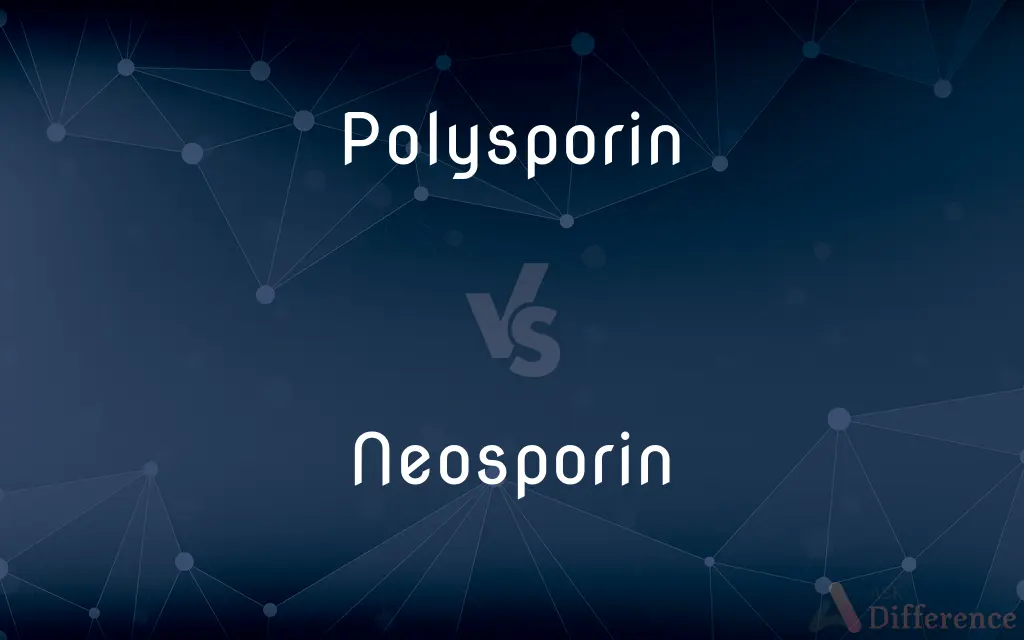Polysporin vs. Neosporin — What's the Difference?
By Tayyaba Rehman & Fiza Rafique — Published on February 22, 2024
Polysporin is a double antibiotic ointment for preventing infection in minor wounds, whereas Neosporin, a triple antibiotic, also aims to prevent infections but includes an additional ingredient for broader bacterial coverage.

Difference Between Polysporin and Neosporin
Table of Contents
ADVERTISEMENT
Key Differences
Polysporin contains two antibiotics: bacitracin and polymyxin B, making it effective against a specific range of bacteria. It's often chosen for its simplicity and lower risk of allergic reactions. Neosporin, on the other hand, includes these two plus neomycin, expanding its antibacterial spectrum. This addition, however, increases the risk of allergic reactions for some users.
Both ointments are used for similar purposes: to prevent infection in cuts, scrapes, and burns. However, Neosporin's formula aims to cover a broader range of bacteria, potentially offering more comprehensive protection. This makes it a go-to for more general use, despite the slight increase in allergy risk.
The choice between Polysporin and Neosporin often comes down to individual skin sensitivity and the specific needs of the wound. Those with sensitive skin or known allergies to antibiotic ointments might prefer Polysporin for its gentler formulation.
Regarding effectiveness, both ointments are proficient at preventing bacterial infections in minor wounds. However, the inclusion of neomycin in Neosporin may make it slightly more effective against a broader array of bacteria, though this can vary based on the bacteria present.
Polysporin is often recommended for those who have experienced reactions to antibiotic ointments in the past, whereas Neosporin's broader coverage might be preferred for wounds in environments with a higher risk of varied bacterial contamination.
ADVERTISEMENT
Comparison Chart
Antibiotic Components
Bacitracin, Polymyxin B
Bacitracin, Polymyxin B, Neomycin
Purpose
Prevent infection in minor wounds
Prevent infection in minor wounds, with broader bacterial coverage
Allergy Risk
Lower
Higher due to neomycin
Effectiveness
Effective against specific bacteria
Slightly more effective against a broader range of bacteria
Recommended For
Those with sensitive skin or allergies to neomycin
General use, especially when broader bacterial coverage is desired
Compare with Definitions
Polysporin
A double antibiotic ointment used to prevent infection in minor wounds.
She applied Polysporin to her son's scraped knee.
Neosporin
Contains bacitracin, polymyxin B, and neomycin.
Neosporin's inclusion of neomycin broadens its bacterial coverage.
Polysporin
Recommended for people with sensitive skin.
Her dermatologist suggested Polysporin because of her neomycin allergy.
Neosporin
A triple antibiotic ointment for preventing infection in minor wounds.
She applied Neosporin to the cut to prevent infection.
Polysporin
Contains bacitracin and polymyxin B.
Polysporin's formula is chosen for its lower risk of allergic reactions.
Neosporin
Offers broader bacterial protection compared to double antibiotic ointments.
For her cat scratch, she chose Neosporin for its comprehensive protection.
Polysporin
Often used when allergies to more common antibiotic ointments are present.
Due to her allergy to Neosporin, she uses Polysporin instead.
Neosporin
Can cause allergic reactions in some individuals.
He switched to Polysporin after developing a rash from Neosporin.
Polysporin
Helps prevent bacterial infections.
To avoid infection, he put Polysporin on his burn.
Neosporin
Ideal for general use on cuts, scrapes, and burns.
After falling, he used Neosporin on his scrapes to prevent infection.
Neosporin
Trade name for a topical drug containing several antibacterials; used as an ointment for skin irritations and in the form of eyedrops for minor eye infections
Common Curiosities
What is Neosporin?
Neosporin is a triple antibiotic ointment designed to prevent infections in minor wounds, with a broader range of bacterial coverage.
Is Neosporin more effective than Polysporin?
Neosporin may be slightly more effective against a broader range of bacteria due to its additional antibiotic component.
Why choose Polysporin over Neosporin?
Choose Polysporin if you have sensitive skin or allergies to neomycin, as it has a lower risk of allergic reactions.
Can I use Polysporin or Neosporin for any wound?
Both can be used for minor cuts, scrapes, and burns but should not be used for deep wounds or burns without medical advice.
Is Polysporin or Neosporin better for burns?
Both can be used on minor burns, but Polysporin may be preferred for those with sensitive skin or allergies.
Are Polysporin and Neosporin safe for children?
Yes, both are generally safe for children, but it's important to use as directed and consult a pediatrician if unsure.
What is Polysporin?
Polysporin is a double antibiotic ointment used to prevent infection in minor wounds.
What should I do if I experience an allergic reaction to Polysporin or Neosporin?
Discontinue use immediately and consult a healthcare provider for appropriate treatment.
Can Neosporin cause allergic reactions?
Yes, Neosporin can cause allergic reactions in some individuals, primarily due to its neomycin content.
How often should I apply Polysporin or Neosporin?
Apply 1 to 3 times daily or as directed by a healthcare professional.
Can Polysporin or Neosporin be used on animal bites?
For minor animal bites, they can be used after proper cleaning, but medical advice is recommended due to the risk of rabies and other infections.
Do Polysporin or Neosporin expire?
Yes, like all medications, they have expiration dates and should not be used past that date for best efficacy and safety.
Can I use Polysporin or Neosporin on my face?
Yes, but avoid contact with the eyes and consult a doctor if applying near sensitive areas.
Can using Neosporin lead to antibiotic resistance?
Overuse of any antibiotic, including Neosporin, can contribute to antibiotic resistance. Use as directed.
Are there any alternatives to Polysporin and Neosporin?
Yes, there are other antibiotic ointments and natural remedies available, but it's best to consult with a healthcare professional for recommendations based on your specific needs.
Share Your Discovery

Previous Comparison
IR Spectroscopy vs. UV-Visible Spectroscopy
Next Comparison
Calcium Chloride vs. Sodium ChlorideAuthor Spotlight
Written by
Tayyaba RehmanTayyaba Rehman is a distinguished writer, currently serving as a primary contributor to askdifference.com. As a researcher in semantics and etymology, Tayyaba's passion for the complexity of languages and their distinctions has found a perfect home on the platform. Tayyaba delves into the intricacies of language, distinguishing between commonly confused words and phrases, thereby providing clarity for readers worldwide.
Co-written by
Fiza RafiqueFiza Rafique is a skilled content writer at AskDifference.com, where she meticulously refines and enhances written pieces. Drawing from her vast editorial expertise, Fiza ensures clarity, accuracy, and precision in every article. Passionate about language, she continually seeks to elevate the quality of content for readers worldwide.














































